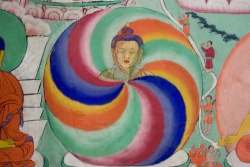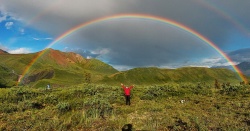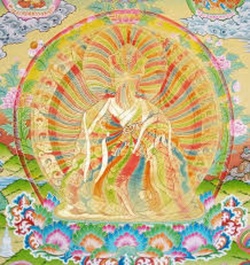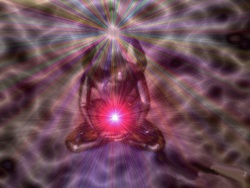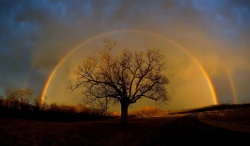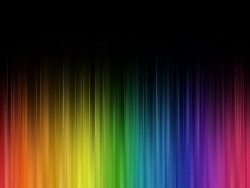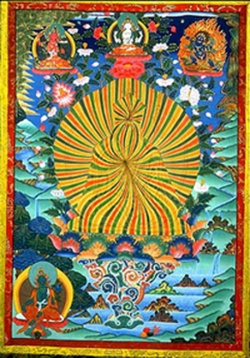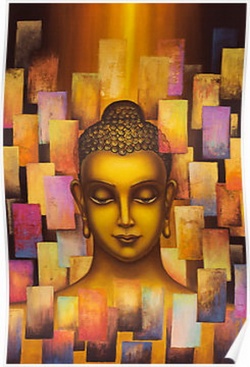Rainbow
The rainbow is eternity’s expression of delight. It cannot but be auspicious, even if it portends the demise of a great master. For such a master – now merged into ‘clear light’ (prabhasvara) of the death process where the most subtle level of mind is experienced as pristine inner radiance – there is no sense of ‘leaving behind’, the notion of self and others having been transcended. For the ‘others’, the disciples or students, there is inevitably a great sense of loss and grief. Yet the miracle of the master’s departing rainbow will always remain as a great source of strength and inspiration for the devotees.
The vaulting arc of the rainbow is known as ‘Indra’s bow’
(Indradhanush), one of the weapons of the ancient Vedic sky god, Indra. The seven colours of the rainbow – red, orange, yellow, green, blue, indigo and violet on the inside. When a double rainbow occurs, the order of colours in the second rainbow is reversed. On rare occasion a similar rainbow effect is created by the moon’s light at night, producing a silver ‘moonbow’ on the opposite side of the sky. A circular rainbow known as ‘glory’, can sometimes be seen from high vantage points, such as hazy mountain summits, forming an aureole halo ring of rainbow light. In Tibetan art the rainbow takes on a more supernatural manifestation. The divine forms of deities manifest and dissolve into emptiness just as a rainbow appears and vanishes into the sky. Rainbows in Tibetan art arise from sacred places or objects, expanding outwards as they twist and interweave with other rainbows or horizontal cloudbanks. They originate from a point and eventually dissolve into space, like winding rivers of light. A miraculous phenomena in the Tibetan tradition is the taking of the ‘rainbow body’ at the time of death.
This miraculous sign of realization is known as the ‘body of light’. When a great master has attained the realization of Mahamudra, the world is no longer perceived as a conceptual concrete dimension. Sine all appearance have transformed into ultimate nature of reality itself – as the fully enlightened ‘body’ of the Buddha (dharmakaya), permeating space with no solidity or separation. When the notion of a individual self has dissolved, leaving no residue of an intermediary ‘I’ between unmanifest consciousness and the appearance of a physical universe as light, the physical body is likewise perceived as merely an appearance of light. Such a master will leave instructions that his body should remain undisturbed for a period of days after his death. During this period rainbow emanates from the place where his body rests, as his consciousness remains absorbed in the state of ‘clear light’. When the miraculous rainbows have ceased, all that remains of the master’s bodily form are his clothes, hair, his fingernails and toenails. Tibetan folklore ascribes various omens to the appearance of rainbows. At the end of every rainbow is believed to be a wish-fulfilling jewel. A rainbow at night is believed to be an ominous sign. White rainbow symbolizes, the death of a yogin. A rainbow around the sun is usually caused by ice crystals, but in Tibet it is seen as an omen of the birth or death of a great teacher.
One of the most frequently painted forms of rainbow-body emanation is that of Padmasambhava, a great Buddhist teacher and tantric master. When Padmasambhava is represented as manifesting on the dharmakaya, sambhogakaya, and nirmanakaya level simultaneously, then three rainbow sources emanates from his crown, forehead and heart centres, respectively. These three rainbow-streams merge together very subtly to produce a harmonious triple whirl-pool of rainbow waves. As finely depicted in this thangka.
The rainbow exemplifies the power of beauty. It is also a prime example of the illusory display that we experience as the physical world: It is patently not something real, but rather an ephemeral or transitory "object" produced by the interplay of light and water.
Relatively, Like a Rainbow
Through this kind of analysis, we come to the conclusion that there is no self, truly existing self. My stress on truly existing self is something to be, you know, highlighted. Because relatively speaking, there has to be a self. There has to be, even as we begin teaching, I said, we should all have the right motivation: to get what? To get enlightenment. There is a self, that is trying to shirk off samsara and awaken to the state of nirvana. The analogy is like the … there are many Mahayana analogies and examples -- Like a rainbow, for instance, a certain amount of sunlight, moisture and angle of sunlight, rain and also the distance from you and the rainbow. When all of these causes and conditions are together, there is something called rainbow : Beautiful, intact. Colours and shapes are not chaotic. It’s all very ordered; dimensions with breadth, everything intact. But clarity -- its colours, its vividness, its intact sort of order -- none of them makes the rainbow truly existing. When the causes and conditions are there, it appears to be there. That’s how the Mahayana sees everything.
Attribute of the Gods
In iconography, which is the decoding of formal images, a symbol that is indicative of the special qualities of a deity is called an attribute. It is usually an object grasped in the hand, but it can also appear separately as a symbol of the deity that serves as a metonymy. In a twist on computer terminology, nowadays we can call it the god's "icon."
The rainbow is a good example of attribute. It is frequently interpreted as a sign of the presence of the sky deity. It is his weapon, her necklace, the Creator's palette of colours or the hem of his or her glorious garment.
In some Tibetan tangkas, the circular rainbow stands for the actual presence of Buddha Samantabhadra, the All-good.
However a bow is primarily a weapon, and so from the Americas to northern Asia, the rainbow is thought to be that which propels the arrows or thunderbolts of the storm deity. For example, the Buriat people of Siberia say that Tengri fights evil spirits with fiery arrows shot from his bow.
The Navajo say that during a period of darkness 12 men, one from each of the directions of space, once tried to use the rainbow as a lever in an unsuccessful attempt at raising the fallen sun.
Deity
In many cultures the rainbow is a distinct deity. To the ancient Greeks, she was Iris the brightly gowned, winged daughter of Thaumas, god of wonder, and the sea goddess Electra, who was a messenger to Hera, Zeus' lawful wife. Iris' attributes are a staff and a pithos or jar. In her role as Hecate, Iris travels to the Underworld to testify to the oaths of the dying and she also has the power to detain their souls.
The Mayans used to make offerings of gold and silver to Ix Chel, goddess of the moon, water and the rainbow, who also ruled childbirth. She was depicted with clawed hands and her skirt was decorated with crossbones. She controlled the rain and her attribute was the jug of deluge which could visit devastation on the land. She also manifested as a sky serpent.
Serpent
A rainbow is also seen as "The serpent that quenches its thirst in the sea" and in Africa, it is a guardian of treasure. In China, it is a sky dragon uniting heaven and earth -- the union of Yin and Yang. In Australia, it is the mother-source of all creation.
Road, Bridge, Staircase
The iridescent ornament of the Mesopotamian Great Goddess, Inanna-Ishtar, the rainbow also serves as a bridge to heaven. Though Ishtar allows the souls of the chosen to ascend to The Great Above via the multi-hued band, she once blocked the way of the sky god when he harmed her children with the Deluge.
In Thai (Buddhist) mythology, the rainbow is a staircase linking the earth to the heavens down which the nagas can descend. Here the colors do not stand for distinct elements, but represent aspects or qualities of the unity that is their source. Hence the rainbow links Samsara -- the world of illusion and suffering, to Nirvana -- formless Emptiness.
If it is usually viewed as a link between heaven and earth, the rainbow is also a path between earthly realms. For example, Irish folklore gives us the notion of a leprechaun's pot of gold at the end of the rainbow.
Unattainable
The Navajo say that gods travel the rainbow which is a rapidly moving road. They believe, too, that no matter how fast we may run towards its end, we can never reach it.
The Sioux say that the rainbow is where all the bright flowers stay before and after their brief blooming period on the earth.
Colours
In Buddhist iconography, the five colours: blue, white, green, red and yellow stand for the five Buddha families. Orange is the hue associated with Bodhisattva, Manjushri. Violet (pale purple) is associated with the protection afforded by Tara.
When people see seven colors in the rainbow, they relate them to the seven traditional celestial planets, or the seven celestial spheres. In Indian mythology, the various hues are the veils of Maya, goddess of illusion, whose garments are depicted with bright bands of colour.
Homer saw only the colour purple in the rainbow. Later, Xenophanes found crimson, yellow and blue. Medieval Christians also saw three, and in the Islamic view, there are four colours -- red, yellow, green and blue -- corresponding to the four elements. Newton found seven, which suited his numerological theory, and that is how we expect to see it. In actuality there are as many colors as wavelengths of light, aren't there?
Omen
Though rainbows are often explained as the bridge from the realm of the gods to the earth, more often, they are seen as a kind of omen. As a sign from heaven, they are interpreted in a variety of ways: a portent of impending war or conversely, a seal of the Creator's promise not to destroy the land in another global Flood.
In India, the rainbow is poetically called Indra's Bow. But for Buddhists, the rainbow recalls the Prajnaparamita teaching on the Emptiness of Form. These striking atmospheric manifestations that occur at transitional times of the year, or of changing weather, are also understood in Tibetan Buddhism as indications of blessings from the buddhas, bodhisattvas, dakinis or deities.
The Consecration of the Land
The consecration of the land on July 25, 2002 occurred during Rinpoche's first retreat program in Crestone. After the opening ceremonies both Thrangu Rinpoche and Khenpo Kartar Rinpoche were looking into the sky (they were under a canopy) and smiling and talking to each other. Shortly after everyone's attention focused on the rainbow in the cloudless sky without rain. This magic rainbow formed a half moon around the sun. The canopy obviously did not obstruct Thrangu Rinpoche or Khenpo Karthar's vision and perhaps they saw more than just the rainbow.
For example, in the midst of the cremation ceremony of the 16th Karmapa, a giant rainbow ringed the sun although the weather was clear and dry. What remained of his heart was seen to roll out of the pyre on the side facing Tibet, and later a small footprint appeared in the ashes in the same direction. Many people from all over the world witnessed those signs.
And, from Karmapa (Scotland: Altea Publishing, 1996) by Ken Holmes:
"At another time she [the 17th Karmapa's mother, Loga] dreamt of eight auspicious symbols wreathed in rainbow light emanating from her heart. The night before the birth, in late June, 1985, the father saw rainbows over the tent and was surprised, for the sun had already disappeared behind the mountains. The baby was born the next day without pain or difficulty, just before the first golden rays of sunlight burst into the tent. At the same time, a cuckoo landed on the yak-hair tent and sang."
At one point during the Karmapa's first international press conference on April 27, 2001 during which he was referred to as a "900-year old teenager," there was a clap of thunder followed by a brief shower which, when the sky cleared, was followed by a rainbow.
Even in the most secular of societies, a rainbow is usually taken as a blessing or at the least, an auspicious sign. Its appearance has the capacity of adding glamor to an otherwise mundane event. In fact the word glamor has a connection with that remarkable optical phenomena.
In Lhasa, on May 1st, International Workers' Day, people were amazed to see the sun surrounded by two bright homo-centric rainbow circles, said Chinese news agency Xinhua. These "glories" are aureoles formed by the presence of ice crystals in the upper atmosphere, but many interpret it as an omen. Its description resembles the one photographed in Europe in 1997.
The Times of India, May 2, 2001 quotes Xinhua:
Some pilgrims believe the circles represent the lustre of the Buddha which symbolises millenarianism. [?]
The inner circle had a diameter 20 times that of the sun and the space between the sun and the circle was pitch-black while the outer circle had a diameter about 40 times that of the sun. The space between the inner and the outer circles was deep blue, it said. The two circles were predominately orange, gradually changing to yellow, green, blue, and white. Like a huge cap covering almost the entire sky over the city.
A Tibetan meteorologist, Purbu Zhoima who has worked in Tibet for several decades said that it was the first time she had seen such a sight.
Aureoles around the sun are generally caused by abundant vapour in the air, a high ground surface temperature and strong sunlight. However, the reason behind such a large-scale double aureole is yet to be found ... .
Jhalu or The Rainbow Body
A teacher or yogi who has acquired the highest forms of accomplishment can manifest what is called "the rainbow body" or "body of light." Usually this happens after death, but it has been known to happen at other times. For example, one of the 8 forms of Guru Rinpoche (Padmasambhava) is The Rainbow. HH the 16th Karmapa was observed by many people as he temporarily dissolved in this way during a Black Crown ritual.
Those who have mastered the trek-chod phase of Dzogchen in which pure and total presence is stabilized, are able to do to-gal. This is the final Dzogchen practice which enables the yogi at the time of death to dissolve his or her physical body into the essence of the elements. The yogin then disappears into a " body of light" leaving behind only the hair, toe and finger nails, and the nasal septum.
Sogyal Rinpoche wrote, "
In 1952 there was a famous instance of the rainbow body in the East of Tibet, witnessed by many people. The man who attained it, Sonam Namgyal, was the father of my tutor at the beginning of this book.
He was a very simple, humble person, who made his way as an itinerant stone carver, carving mantras and sacred texts. Some say he had been a hunter in his youth, and had received a teaching from a great master. No one really knew he was a practitioner; he was truly called a "hidden yogin."
. . . he then fell ill, or seemed to, but became strangely, increasingly happy. When he illness got worse, his family called in masters and doctors. His son told him he should remember, 'Everything is illusion, but I am confident that all is well.'
Just before his death at seventy-nine, he said "All I ask is that when I die, don't move my body for a week." When he died his family wrapped his body and invited Lamas and monks to come and practice for him. They placed the body in a small room in the house, and they could not help noticing that although he had been a tall person, they had no trouble getting it in, as if he were becoming smaller. At the same time, an extraodinary display of rainbow-coloured light was seen all around the house. When they looked into the room on the sixth day, they saw that the body was getting smaller and smaller. On the eight day after his death, the morning in which the funeral had been arranged, the undertakers arrived to collect the body. When they undid its coverings, they found nothing inside but his nails and hair.
Green Tara is often depicted wearing a rainbow of leg-wrappings that resemble striped stockings. They are a sign of her ability to manifest in this world.
Not long ago, a mummified man's body was discovered in northern Eurasia wearing strikingly similar garb.
